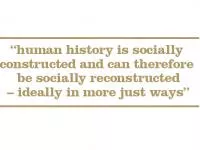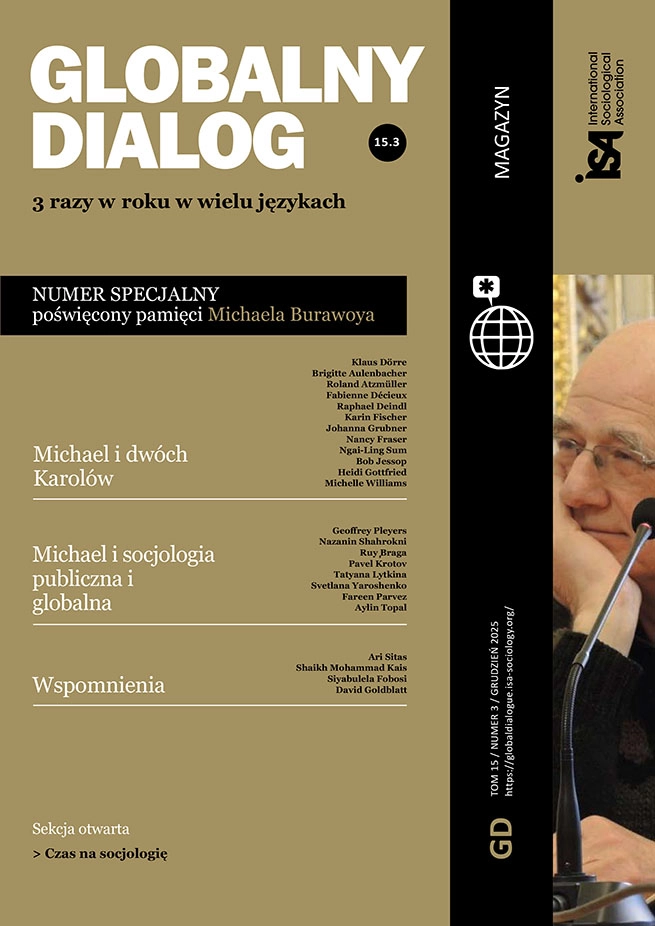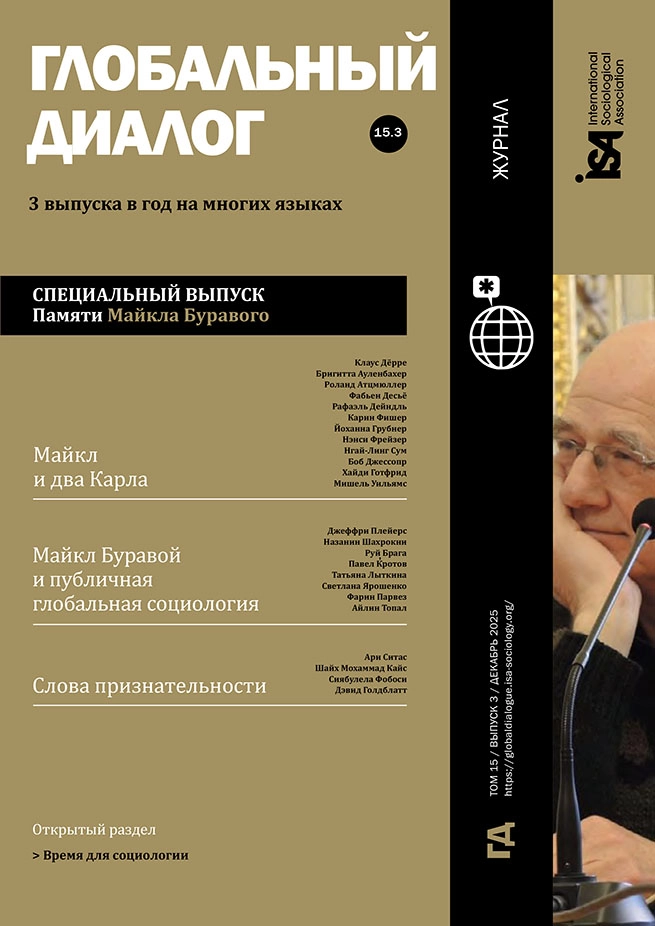I first met Prof. Michael Burawoy in person at the Conference of the Council of National Associations of the International Sociological Association (ISA) in Ankara in 2013. At the time, he was serving as the President of the ISA. Since then, I became an active member of the ISA and Michael and I remained in contact, meeting at ISA conferences and exchanging emails on important political events. He was truly a transdisciplinary social scientist. I, as a political scientist, became a member of the ISA thanks to his welcoming attitude and firm transdisciplinary question-driven research.
Michael and I had a common friend: Erik Olin Wright, whom we lost in 2019. Erik reflected deeply on life, death, and the afterlife in his journal articles while battling leukemia. I remember exchanging emails with Michael about Erik’s materialistic lens, embracing the idea that our physical bodies return back to the universe in the form of stardust: a profound connection to the cosmos. I know that Michael embraced this deeply humanistic approach of reintegration into the natural world. Not only will he continue to exist in the form of stardust, but he will also be read and cited by many scholars examining the nature of the capitalist labor process and dynamics of class struggle. This piece is to honor his contribution to the literature.
Labor power
The production process occupies a central place in economic theory. After all, the definition of economy starts with production, which can be defined as transforming objects with a specific use value into objects with a different use value. Therefore, production corresponds to production of a new use value. It is the power of labor acting on the means of production to transform the objects that produce new use value. This transformation and the new use value are meaningful for markets to the extent that they correspond to a higher exchange value.
At the core of capitalist production lies a central antagonism. In the capitalist markets, laborers do not own the means of production with which they have to interact to produce the higher exchange value. For this to happen, capitalists have to invest in labor power. This investment in labor power is inevitable for capitalists because labor power is uniquely capable of transforming objects and producing new exchange value that exceeds the previous exchange value of the object. Investing in labor power is profitable to the extent that the value laborers create is higher than the exchange value of that labor power. The wage is the exchange value of labor, which is a socially determined level sufficient to reproduce labor power and maintain the laborers’ families. Meanwhile, capitalists have to make profit by making the laborers work more than the time that is necessary for the creation of new value equal to the wage of their labor power.
Therefore, the capitalist labor process inevitably extends beyond the production of use value and the exchange value of labor to encompass the production and private appropriation of the socially produced surplus value. The capitalist labor process involves the relations between production aimed at maximizing the extraction of excess unpaid labor, on the one hand, and maximizing the exchange value of labor power beyond the minimum subsistence level, on the other. Despite the centrality of these tensions embedded in the social relations of production, detailed research and engaged debate on production and the labor process were largely lacking until the 1970s.
Pioneering critical works
In 1954, a group of social scientists sought to study labor relations and industrial systems across different countries in a comparative perspective focusing on economic development, labor markets and state–business–labor relations (aka industrial relations). The central motivation for those studies was the desire to discover the universal patterns of industrialization along with sui generis labor relations and industrial formation shaped by the cultural and political context in each market. The research of this group, funded by the Ford Foundation, yielded a co-authored volume in 1960, entitled Industrialism and Industrial Man by Clark Kerr and others. The book focuses on the influence of the leaders of industrialization in each country on the actual path of the industrialization process. These studies failed to go beyond the modernization theory framework emphasizing the role of “industrialization elites” mediating between workers and employers for stability and economic growth. Their functionalist conception of causal relations, ahistorical character and tendency towards tautology did not initiate any debate outside their own circles.
Harry Braverman’s Labor and Monopoly Capital: The Degradation of Work in the Twentieth Century published in 1974 was one of the pioneer works in critically examining the centrality of the labor process in capitalist society. Braverman argued that capitalism refers to the emergence of modern techniques but in its due course corresponds to widespread erosion of skills both in factories and offices. He reads the history of capitalism as one of deskilling the masses while skilled labor had been confined to a very small number of laborers including engineers and managers. Deskilled labor, on the other hand, becomes an interchangeable appendage of the machines. In short, Braverman underlined that Taylorism is “nothing less than explicit verbalization of the capitalist mode of production.”
Braverman’s deskilling argument bears striking similarities to the themes depicted in Charlie Chaplin’s Modern Times (1936) criticizing the dehumanizing effects of industrialization and the capitalist labor processes. Fragmenting complex tasks into repetitive and simple ones alienates workers from their labor and their sense of purpose and value are consumed by machines. It is true that the technical division of labor in the capitalist production process inherently shapes the labor process; a complicated production process is not an undifferentiated process, but rather one that is internally fractured through the capitalist division of labor. As different branches of production compartmentalize this process, laborers do not engage with all the transformations that the commodity goes through but usually interact with it at a particular stage in its production. This powerful critique of the capitalist labor process inspired other works and successfully sparked a heated debate on the labor process among scholars across various fields.
Insight from Friedman and Edwards: the need for ethnographic research
Once Braverman stripped the veil off the capitalist labor process, the debate focused particularly on a very simple yet crucial question: Why do workers work as hard as they do? This leads one to ask: How do workers internalize the fundamentals of capitalism that constrain them? Critical responses to these questions came from Friedman, Edwards, and Burawoy. Andrew Friedman emphasized another face of capitalist labor control, a more humane face. He claimed that, instead of direct control or supervision, workers are provided with a “responsible autonomy” in which they comfortably identify themselves with the aims of the firms. Friedman highlights the variability and adaptability of managerial control shaped by the resistance strategies of workers. Similarly, Richard Edwards offered a more nuanced perspective on the relational and strategic nature of workplace relations.
Edwards noted that Braverman’s analysis tends to generalize the main features of Taylorism throughout the history of capitalism. The scientific management principles of Taylorism left their bold mark on labor process control through the twentieth century. Yet, it should still be regarded as one form of control management. Edwards identifies three models, simple, technical, and bureaucratic, each representing a different management strategy. He introduces the concept of “contested” workplaces, where control is not necessarily absolute but constantly negotiated between workers and management. Therefore, as opposed to Braverman’s passive portrayal of workers, Edwards places significant emphasis on the conflict-ridden nature of workplace relations and workers’ resistance. Although both Friedman and Edwards incorporated the agency of workers into their analysis, they failed to satisfactorily respond to the puzzling questions.
To answer the question of how it is that workers consent to their own exploitation within the capitalist labor process, the researcher needs extreme empathy. Understanding a subject’s perspective in social science is a complex and often challenging endeavor. The researcher needs to suspend assumptions and theoretical preconceived ideas to authentically grasp the lived experiences of others. True empathy is also limited as the researchers’ perspective is shaped by its social context. To be able to expand beyond the limits of empathy, the researcher needs direct access to the subjects’ reality. Therefore, ethnographic research is necessary to be able to answer these questions about the labor process.
Burawoy’s foundational ideas
Michael Burawoy did not only have extraordinary intellectual rigor but also a deep sense of empathy, commitment to humility and reflexivity. With these qualities, he contributed to the labor process debate. The main difference between him and other scholars was that he tried to answer these questions not from the researcher’s distant objective position but by deriving answers from his subjective experience as a factory worker. He spent significant time working in factories and this profoundly shaped his understanding of workplace dynamics, worker consent, and the interplay between labor and the capitalist labor process.
His Manufacturing Consent: Changes in the Labor Process under Monopoly Capitalism is based on his experiences as a factory worker at the Allied Corporation machine shop in Chicago. Burawoy starts precisely with questions of how workers actively assume and reproduce the role of management. He notes that possible answers to these questions should be sought within the capitalist labor process, as it manufactures both consent and commodities. Similarly to the case of Friedman’s “responsible autonomy” conceptualization, Burawoy notes that workers perceive themselves as having choices.
It is precisely this illusion of choice that makes workers actively internalize the rules of capitalist control over the labor process. As a machine operator, Burawoy lived the daily routines and social interactions of the factory floor. He narrates how he himself had felt the pressures of production quotas, managerial control, and relations among the workers when dealing with such pressures. He provides valuable details about how workers sought to exceed production quotas in order to gain rewards or extra breaks. He argues that these game-like strategies that he calls “making out” constitute elements of consent to their own exploitation. He also claims that emphasis on the concept of control obfuscates the actual working of capitalism. Rather, he emphasizes the interplay between coercion and consent within the labor process obscuring the exploitative nature of capitalism.
Production politics in capitalist, socialist, and postcolonial societies
He later expanded these foundational ideas to a broader global, macro-level context in his next book The Politics of Production published in 1985. In this book, he focuses on the political and institutional frameworks of production in different spatio-temporal contexts. He suggests “production politics” are determined by state policies, labor markets, and the dynamics of the class struggle. Under these determinants, the organization of work and the shopfloor are shaped into different labor regimes and systems of production politics in capitalist, socialist, and postcolonial societies.
In capitalist societies, he emphasizes the importance of management, given the priority of profit maximization. He points out how labor laws, welfare policies, and ideological elements maintain control over the workers. In the state socialism of the Soviet Union, negotiations between workers and managers over bureaucratic control often lead to conflictual relations due to the mismatch between the state’s priorities and workers’ needs. These elements foster socialist production politics, offering different incentives for manufacturing consent and establishing resistance mechanisms. Lastly, for post-colonial production politics, Burawoy takes his level of analysis to the global scale to make sense of how imperialist relations continue to determine labor processes in the post-colonial context. His elaborations on how global capitalism shapes labor regimes inform his perspective on neoliberal labor processes.
Burawoy operationalizes Marx’s analysis, highlighting the imperative of productivity
With these two complementary books, Burawoy provides a comprehensive framework for understanding labor processes, linking the everyday experiences of workers to broader political and economic forces. Therefore, he highlights the importance of connecting the analysis at different levels. He also suggests that control and consent, as elements of the capitalist labor process, should be considered together, as they correspond to the two-sided nature of capitalist social relations of production. He notes that labor is simultaneously empowered and repressed in the workplace, as part and parcel of the concerns with rendering hegemonic a particular conception and condition of the relations of production.
Burawoy’s analysis necessarily brings the imperative of labor productivity to the fore. He effectively operationalizes Marx’s analysis of the labor process. Working life is objectively organized around productivity. -> It is productivity that creates surplus value. -> Self-valorization of capital to the greatest possible extent is the driving motivation of capitalists. -> When the owner of money finds free labor power on the market and possesses it, money becomes transformed into capital to be accumulated. -> Social labor in collectivities is more productive than individual workers. More precisely, labor is productive as collective power. -> The aim of capitalism is to increase profitability as much as possible. -> For more accumulation, the capitalist buys labor power from large numbers of workers in order to increase the productive power of social labor. -> Therefore, numerous workers are employed and work together side by side, whether in the same process or in different but connected processes, in order to increase productivity. This chain of argument brings us to what Marx calls “co-operation of workers.” What is more, co-operation of workers is conducted in accordance with a plan that is crafted by the managers and supervisor on behalf of the property owners.
Burawoy’s framework notes that the division of labor is not the end but the means to attain productivity. The capitalist system, therefore, reproduces itself through the productivity of labor, as increased productivity of labor means greater production of surplus value. One fundamental way to increase productivity has been to increase the technical division of labor. Therefore, management is to facilitate productivity, not necessarily to execute the division of labor. Prima facie, laborers individually produce parts of the commodity, but production is indeed a social process. It is the collective labor that produces the entire product. Therefore, the capitalist labor process produces hegemony simultaneously by turning workers into isolated individuals as well as by keeping them as part of the collective labor force. As proposed by Marx, the collective power of social production is brought about by organizing labor “into one single productive body”, for the purpose of improving its productivity.
Burawoy’s framework for the production of class hegemony
Burawoy notes (as does Marx) that capitalists and their management strictly control the labor process. The subjugation of labor to capital is the formal result of the fact that the worker works for and consequently under the control of the capitalist. Essentially, the command of capital defines the requirements for conducting the labor process itself. Directing authority is necessary for harmonious cooperation and the development of productive organizations. Therefore, the work of directing, superintending, and adjusting the labor process becomes one of the functions of capital. Yet, the motivation of capitalists to control the labor process is not confined to increasing cooperation and productivity. Capital and labor are inherently in a struggle over the control of working time and the appropriation of the surplus product. Management and supervision are crucial tools in combating an upsurge of revolt in the workplace. The element of consent is constantly implicated in Marx’s analysis. However, since Marx was writing primarily a political text – as opposed to Burawoy’s sociological text – he does not address the question of how and why the working classes consent to management.
Burawoy’s studies provide an insightful framework for examining the production of class hegemony, focusing on how the capitalist labor process impedes the rise of antagonistic forms of consciousness. However, he notes that workers often feel discontent and frustration in the workplace due to the pressure of production quotas, strict supervision, and repetitive tasks. It is not precisely class consciousness but rather the consciousness of an opposition that expresses itself in new modes of action. Although workers consciously recognize that the business is one of making a profit by extracting the surplus value they produce, their demands are merely for dignity and autonomy. Thus, workers’ objective relations to the means of production certainly generate conflicts which shape workers’ experience in “class ways”. As Thompson suggests, class is always present in forms of frustration and discontent, yet these tensions do not necessarily express themselves in class consciousness.
Burawoy employs Gramsci’s framework of hegemony, which combines consent and coercion with moments of collective will formation. Gramsci provides a rich theoretical and conceptual framework that helps us understand the transformation of individual subjectivity within the totality of praxis as moments of collective will formation. Burawoy’s narrative illustrates how workers’ daily experiences diverge from one another, undermining their collective identity and collective will formation. This is why workers compete with each other, for example, to meet their individual quota for extra benefits. Their individual economic interests could be making it difficult for sections of workers to act in solidarity.
As Filippini notes, Gramsci defines individuals as stratified, contradictory beings constituted in their relationship with society. Therefore, the individual is seen as a “collective man” constructed by common sense, changing continuously within the ideological terrain. Burawoy notes the importance of the ideological terrain in Politics of Production, although he does not go into country-level analysis. Nevertheless, Burawoy underlines the fact that he refers to the US context where the absence of a political and intellectual leadership of the working class leads to competition of workers among themselves. Hence, stratified and contradictory individual interests are a result of the inability of the workers to translate their interests into a collective organism.
As Panitch and Gindin note, Burawoy conforms trade unions as a central hegemonic apparatus of the working class that could draw different fractions of the working class into a dialogue and translate between their different practices. It is clear that the labor process, without collective political agency, would not allow different segments of the working class to transcend their economic–corporate moments on the basis of the solidarity of interests, even in the purely economic field. Even worse, under the global neoliberal assault, workers are dispossessed of the capacity of their trade unions as the principal political organization for the actions of the subaltern classes.
In lieu of a conclusion
Burawoy’s work is motivated by two propositions: a) the fundamental reality of the worker’s life is shaped at the workplace; and b) changes in the labor process relate to changes in the composition of capitalism. From these propositions, it is still necessary to provide analyses of the neoliberal transformation of the organization of work and its impact on the formation of workers’ collective will.
It is evident that accelerated privatization in the neoliberal era has had an actual impact on workers in privatized companies who tend to lose their jobs en masse and are deprived of their social rights. Yet, workers have shown very weak signs of discontent towards these privatization policies. More research is needed regarding the absence of symptoms of restlessness in relation to privatizations.
New studies should highlight the centrality of the labor process and the experiences of laborers in earning their living, along with an analysis of hegemony and counter-hegemony under neoliberalism. It is also pertinent to note that, in the neoliberal era, workers’ experiences in the workplace may vary. Rather than identifying and analyzing a unified and coherent neoliberal labor process, new studies should adopt initial standpoints that reflect the notion that the labor process takes different forms and shapes in other sectors of the economy. Michael Burawoy’s methodological and conceptual framework will continue to guide new ethnographers in coming to terms with their fieldwork experiences.
Aylin Topal, Middle East Technical University, Turkey <aylintopal@gmail.com>









